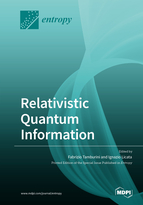Relativistic Quantum Information
A special issue of Entropy (ISSN 1099-4300). This special issue belongs to the section "Quantum Information".
Deadline for manuscript submissions: closed (20 December 2019) | Viewed by 26286
Special Issue Editors
Interests: electromagnetic and gravitational vorticities (classical and quantum); quantum information and teleportation; general relativity; astronomy at the quantum limit
2. School of Advanced International Studies on Applied Theoretical and Non Linear Methodologies of Physics, 70121 Bari, Italy
Interests: foundation of quantum theories; quantum cosmology; de sitter holographic models; dissipative quantum field theories; physics of emergence and organization; fisher information; sub- and super-turing computation models
Special Issues, Collections and Topics in MDPI journals
Special Issue Information
Dear Colleagues,
Relativistic quantum information (RQI) is a multidisciplinary research field that involves concepts and techniques from quantum information with special and general relativity.
General relativity and quantum physics are two estabilished domains of physics that have until now been mutually incompatible. Hawking radiation, the black hole information paradox including soft photons and gravitons, the equivalence between the Einstein–Rosen bridge from general relativity and the Einstein–Podolski–Rosen paradox from quantum mechanics are examples of the new phenomena that arise when the two theories are put together. RQI uses information as a tool to investigate spacetime structure. On the other hand, RQI helps to identify the applicability of quantum information techniques when relativistic effects become important: entanglement and quantum teleportation can be used to reveal gravitational waves or realize a quantum link between satellites in different reference frames in view of future large-scale quantum technologies.
The aim of this Special Issue is to take stock of state-of-the-art perspectives on RQI, with particular attention to the concept of quantum information and the repercussions of RQI on the foundations of physics.
Dr. Fabrizio Tamburini
Prof. Dr. Ignazio Licata
Guest Editors
Manuscript Submission Information
Manuscripts should be submitted online at www.mdpi.com by registering and logging in to this website. Once you are registered, click here to go to the submission form. Manuscripts can be submitted until the deadline. All submissions that pass pre-check are peer-reviewed. Accepted papers will be published continuously in the journal (as soon as accepted) and will be listed together on the special issue website. Research articles, review articles as well as short communications are invited. For planned papers, a title and short abstract (about 100 words) can be sent to the Editorial Office for announcement on this website.
Submitted manuscripts should not have been published previously, nor be under consideration for publication elsewhere (except conference proceedings papers). All manuscripts are thoroughly refereed through a single-blind peer-review process. A guide for authors and other relevant information for submission of manuscripts is available on the Instructions for Authors page. Entropy is an international peer-reviewed open access monthly journal published by MDPI.
Please visit the Instructions for Authors page before submitting a manuscript. The Article Processing Charge (APC) for publication in this open access journal is 2600 CHF (Swiss Francs). Submitted papers should be well formatted and use good English. Authors may use MDPI's English editing service prior to publication or during author revisions.
Keywords
- quantum information
- relativity
- entanglement
- quantum gravity models
- holographic principle
- black hole information paradox
- Bekenstein bound
- ADS/CFT correspondence
- physical limits to computation
- RQI experiments and technologies








